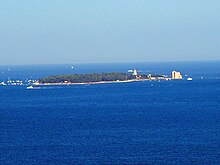Île Saint-Honorat
Saint-Honorat is one of the group of four French Leriner Islands, the Îles de Lérins . It is the second largest after Sainte-Marguerite , which is a few 100 meters north, separated by the passage of Trioul . The dwarf island of Saint-Ferréol is only 250 meters to the east. Saint Honorat has a length of 1.5 kilometers and a width of 600 meters.
The closest city on the coast is Cannes , 5.7 kilometers north. From there the island can be reached in a good half an hour by ferry. Other neighboring towns are Théoule-sur-Mer 8.6 kilometers to the west and Antibes 10.1 kilometers to the northeast. In the east and south, the Mediterranean extends to Corsica .
founding
The initially uninhabited island was already known to the Romans as "Lerina". However, early on it became a nucleus of western monasticism . The first monastery in France is the Abbey of Saint-Martin de Ligugé near Poitiers , founded by Saint Martin in 361. However, Honoratus von Arles founded the Lérins Abbey around 400/410 in the solitude of the Lerin Islands . While traveling to Egypt and Syria, he had got to know the beginnings of monasticism there and had made the plan to live as a hermit in his western homeland, following this example . He quickly found many followers. By 427 the monastery was already a considerable size. A large number of bishops emerged from him in the 5th and 6th centuries, including Caesarius of Arles and Patrick of Ireland . Around 660, Abbot Aigulf introduced the Benedictine rule in the monastery.
history
In the course of the following centuries, the peaceful monastic life on the island was repeatedly disrupted by raids. Around 732 many of the friars , including Abbot Porcrius , were massacred by intruders. The raids by the Saracens and pirates were particularly threatening in the period that followed . To protect themselves from this, the monks built a fortress tower in 1073, in which all the facilities of a monastery such as a chapel, two-story cloister , bedrooms or storage cellars were housed. The entrance, which is 4 meters high, was previously only accessible via a ladder.
But despite these defenses, the abbey suffered from Spanish and Genoese attacks in the following years . In 1635 the Spaniards occupied the island for two years and drove the monks away. Only when the island belonged again to France did they return from exile.
The troubled situation was not conducive to monastic life. The number of monks decreased; the monastery was dissolved in 1787. During the French Revolution , the island became state property. Even Napoleon recognized the strategic value of the island: At both ends of the island still large furnace systems today can be seen, where cannonballs were heated by fire, to combat more effectively to wooden sailing ships.
During the Revolution, the island was sold to the wealthy actress de Sainval, who lived there for twenty years. But as early as 1859, the Bishop of Frejus bought the island back; the destroyed monastery buildings were restored or rebuilt. Ten years later, Cistercian monks moved in from the Provençal abbey of Sénanque .
The location of the island also led to structural changes in the 20th century. Witnesses of the German occupation in World War II are two gun bunkers that were supposed to protect Cannes and the surrounding area from an Allied invasion.
present
Today around 30 monks live in the monastery. The monastery and the associated vineyards take up a third of the eastern part of the island.
The preserved fortress tower in the south-eastern part of the island is a tourist attraction with a good view of the sea and the yachts. Of the seven chapels on the island, the best preserved are the Chapelle St-Sauveur in the north-west and the Chapelle Ste-Trinite in the south-east. A park-like landscape of pine trees and cacti is laid out on the island .
The monastery offers homemade wines and the Lérina liqueur for sale. There is also a sun-protected restaurant , which is very busy despite the quiet monastery life. On some days you can meet a lot of visitors here. The quiet bays in the southern part of the island are less visited than the northern ones.
Web links
- Tourist website ( Memento of December 26, 2007 in the Internet Archive )
Coordinates: 43 ° 30 ' N , 7 ° 3' E





